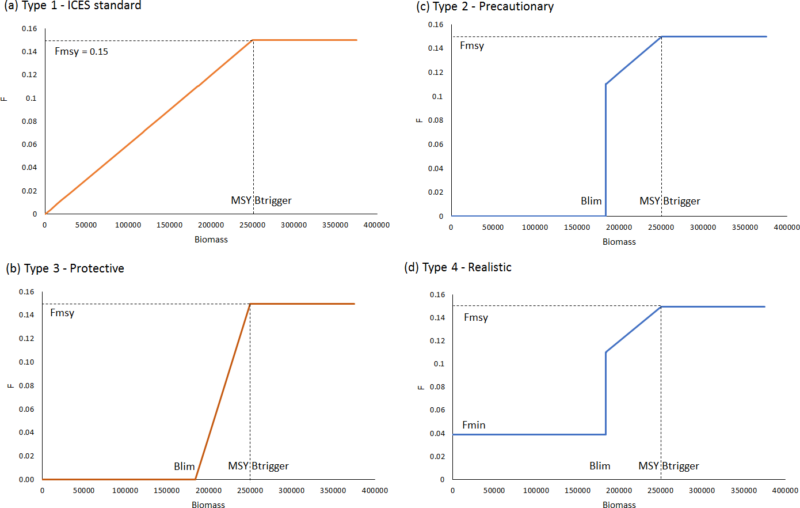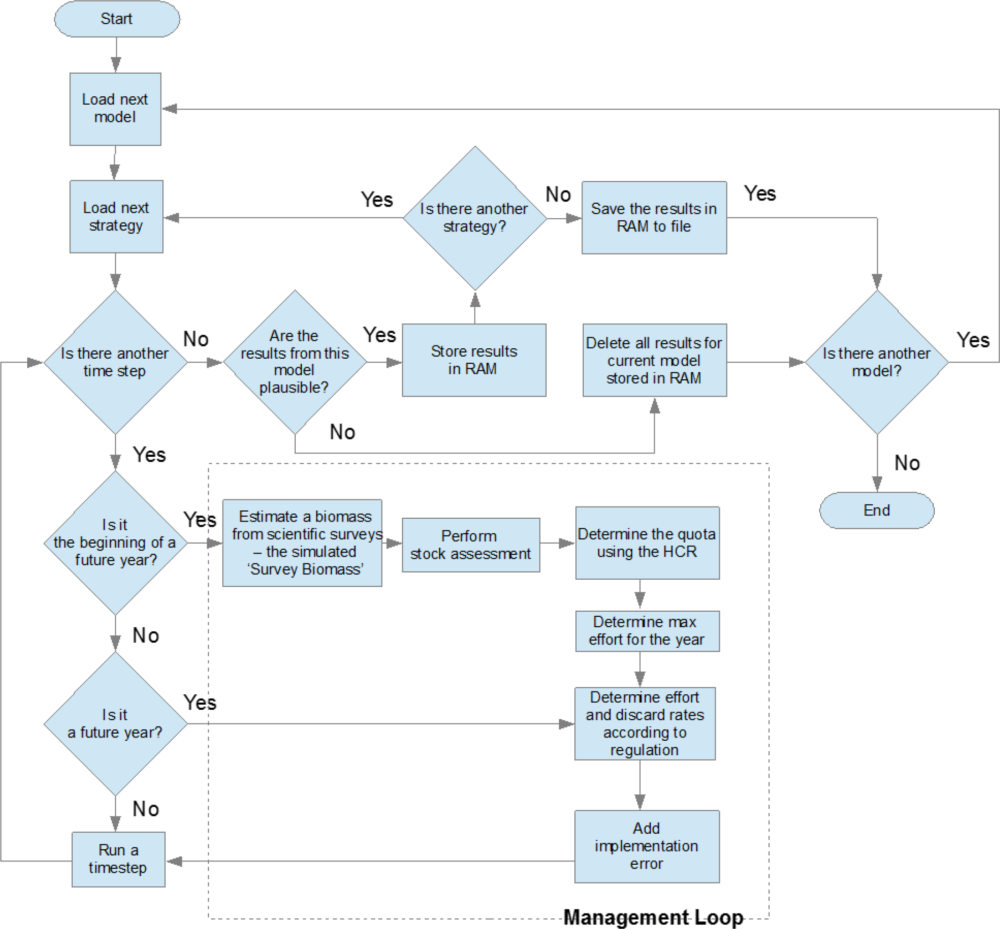38 Management strategy evaluation
Management strategy evaluation (MSE) is concerned with evaluating uncertainty about the impact of applying alternative formal rules for varying fisheries over time, given uncertainty about ecosystem dynamics (as represented by key Ecopath and Ecosim parameters) and about biomass states over time due to stock assessment errors. The main tool in EwE for simulating such uncertainties and rules is the “CEFAS MSE plug-in” (Tools > Cefas MSE) developed by Mackinson and colleagues.[1]
The CEFAS plugin provides a way to represent uncertainty by doing multiple simulation scenarios with different parameter values, while comparing various management performance measures across these simulations for alternative harvest management decision rules. The decision rules included in the plug-in were developed in response to questions raised about multi-species management strategies in the ICES (North Sea) management area, but broadly represent harvest management decision rule options for most highly managed areas in the world.
Management decision rules are represented by several main components:
- So-called “harvest control rules” (HCRs, see Figure 1) representing desired patterns of variation in total fishing mortality rate for target species as a function of species biomass (comparisons of such HCRs is a central concern in single-species management strategy evaluation).
- Imposition of alternative rules for discarding, e.g. forbidding discarding may effectively cause “weakest stock” management by not allowing fishing fleets to avoid harvest limits by discarding catches of weaker stocks), or allowing highest value management by seeking fleet operations that will maximize total profit despite discarding impacts, or assuming ability of fleets to do “selective fishing” of only valued target species.
- Limits on total fishing effort by fleets and on year-to-year allowable changes in fishing effort.
Quite complex calculations are done at each simulation time step in order to meet (or not) the constraints implied by the single-species HCRs. For details, see the supporting information from Mackinson et al.[2]

Figure 1. Examples of harvest control rules (HCRs) used for management strategy evaluation. Type 1 is the “ICES standard” advice rule where F declines linearly to zero when biomass is below MSY Btrigger. Type 2 is “Precautionary”, easing the rate of reduction in F between MSY Btrigger and Blim. Type 3 is the most “Protective”, applying the most severe reductions in F, which declines linearly from Fmsy at MSY Btrigger to zero at Blim . Type 4 is considered the most “Realistic”, similar to Precautionary, but recognizes that a small level of residual non-target by-catch mortality may remain on a stock at B ≤ Blim. From Mackinson et al. (op. cit., Figure 4).
A key part of management strategy evaluation is to determine the effect on management performance of errors in biomass estimates due to random survey variation and to cumulative errors caused by stock assessment procedures. For multispecies models, it is not practical to simulate the complex data gathering and assessment model fitting procedures that are used to obtain biomass estimates for more valuable species. Instead, the plug-in uses an observation by Walters[3] that errors in biomass estimates from common stock assessment methods (virtual population analysis, statistical catch at age analysis or stock synthesis models) propagate over time in a relatively simple pattern that can be modelled by a statistical filtering equation. The equation predicts that even single large survey errors can cause errors in stock assessments (impacts on estimates from assessments) that propagate over several years so as to possibly have large cumulative impacts on over- and/or under-harvesting.

Figure 2. Flowchart indicating how the CEFAS MSE plug-in first creates a (large) number of possible EwE models (drawn randomly) then continues to the management strategy evaluation (Figure 3). From Mackinson et al. (op. cit., Figure 1)
The CEFAS MSE plug-in approach has two stages. First it creates a number of plausible EwE (Ecopath) models by sampling distributions of input parameters (biomass, feeding, production and consumption rates and predator-prey interaction rates) (Figure 2). Next, it simulates the effect of alternative management strategies defined by their HCR and regulatory mechanisms (Figure 3).
For guidance of how to use the CEFAS MSE plug-in, most notably see the paper by Mackinson et al. (op. cit.), the chapter about the CEFAS MSE in the EwE User Guide based on the supplementary materials from Mackinson et al. (op. cit.) as well as the tutorial following this (web and pdf versions only).

Figure 2. Flowchart for evaluation of alternative management strategies. From Mackinson et al. (op. cit., Figure 2).
- Mackinson S, Platts M, Garcia C, Lynam C (2018) Evaluating the fishery and ecological consequences of the proposed North Sea multi- annual plan. PLoS ONE 13(1): e0190015. https:// doi.org/10.1371/journal.pone.0190015 ↵
- Mackinson et al. (2018) S1 Supporting Information. Technical methods of the uncertainty and MSE routine. https://doi.org/10.1371/journal.pone.0190015.s001 ↵
- Walters C. 2004. Simple representation of the dynamics of biomass error propagation for stock assessment models. CJFAS 61(7):1061-1065. https://doi.org/10.1139/f04-120 ↵

